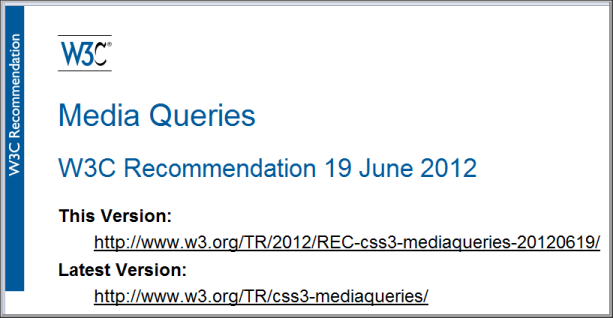Status: For review by Chairs and Advisory Board. The W3C has invited Chairs and the Advisory Board to review this document. After the review period the staff intends to integrate the material into the W3C site.
Comments:
W3C produces different types of materials. Some publications are standards that can be referenced normatively. Some W3C materials are not standards, and should not be referenced normatively.
W3C Standards are produced by W3C Working Groups under the W3C Process and the W3C Patent Policy. To learn more, see the value of creating standards at W3C.

Identifying standards: W3C Standards are called "W3C Recommendations", and are listed in a Standards page. W3C Standards have "W3C Recommendation" near the top of the document, as shown in Figure 1.
Only W3C Recommendations should be referenced normatively. If a W3C document is not a "W3C Recommendation", do not reference it normatively.
The information below on URIs, ISO/IEC Standards, languages, and creating a bibliography applies to all references, including normative references.
W3C also publishes non-normative/informative material, developed under a variety of processes, copyrights, and patent policies. Informative material should not be referenced normatively.
W3C non-normative material includes:
It is important to understand that some of this material is not approved by W3C Working Groups, staff, or Members. When you reference W3C material, make sure you know and communicate its approval status.
When referencing informative material, make sure to clearly indicate that is it not a normative standard.
For additional guidance on using and referencing W3C work, including example attributions, see the W3C Copyright FAQ.
W3C Recommendations and other Technical Reports have two types of URIs, in order to meet different needs for stability:
Figure 1 above shows these two links.
For information about how W3C uses these URIs as documents evolve, see Version Management in W3C Technical Reports.
Some W3C Recommendations are recognized as ISO/IEC Standards. W3C Recommendations that are also ISO/IEC Standards have identical technical content, and thus in some contexts you can refer to either the W3C Recommendation or the ISO/IEC Standard. However, W3C Recommendations are available at no cost, and W3C may have published errata, test suites, techniques documents, and other materials to supplement the Recommendation.
Therefore, when referring to the ISO/IEC standard, also include a reference to the original W3C Recommendation and any related information on the W3C website so that readers can find additional resources.
ISO/IEC standards can include normative references to W3C Recommendations (because of ISO/IEC recognition of W3C). To learn more about ISO/IEC and W3C Recommendations, see the W3C PAS FAQ.
The official language of W3C materials is English, and W3C welcomes translations. Most translations are unofficial; some translations are Authorized W3C Translations.
Always reference the English version of a document. If a relevant translation is available, include a link to the translation as well. Authorized Translations can by referenced normatively. If you link to an unofficial translation, make sure to clearly indicate that is unofficial.
W3C offers a tool for generating a bibliography of W3C Recommendations, Working Group Notes, and other Technical Reports.